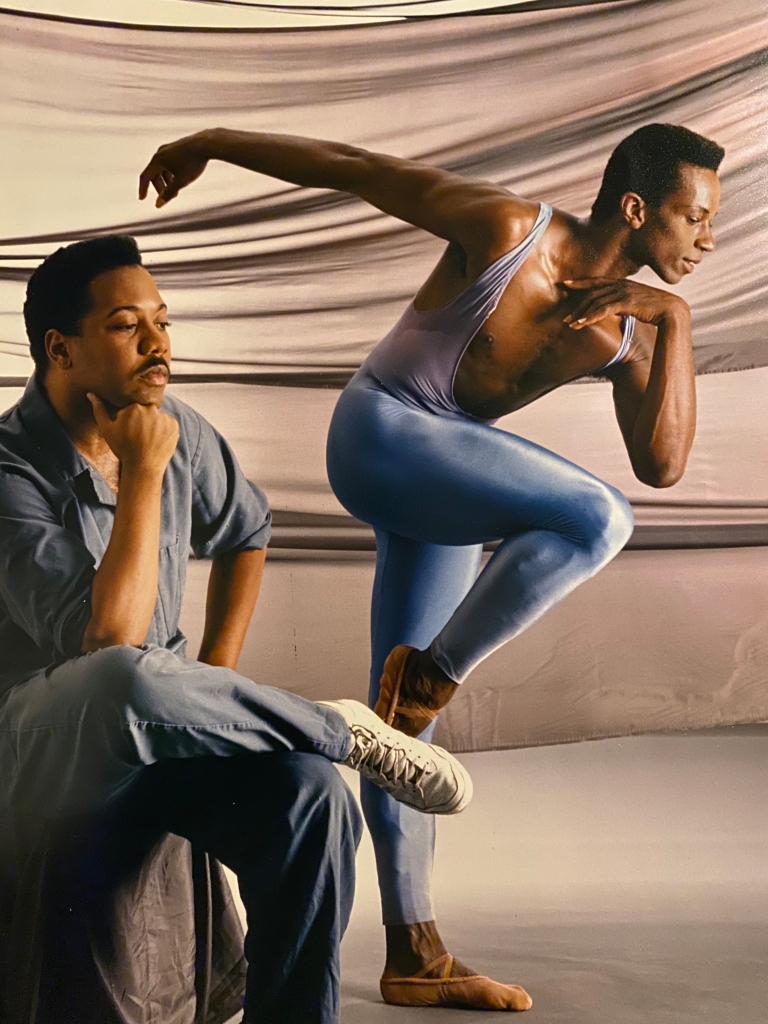
In honor of Black History Month, we are sharing the stories of three African-American dancers who Alonzo admired as a young artist. First in our series is an artist our students might recognize from the walls of Studio 6: Christopher Boatwright, a principal dancer with The Stuttgart Ballet, San Francisco Ballet, and LINES Ballet and a lifelong friend of Alonzo King.
Christopher Boatwright grew up in Brooklyn and excelled in sports. He encountered dance in high school and began training with Merce Cunningham. After graduation, he auditioned for American Ballet Theatre’s school and received a scholarship, along with a young Alonzo King.
“I remember him saying to me, when we were kids, ‘I never want to stop dancing,” King told SFGate in 1997. “He didn’t want to be famous. He didn’t want to be rich. He wanted to be a great artist.”
In 1973, Boatwright saw The Stuttgart Ballet perform Eugene Onegin at the Metropolitan Opera House and was inspired to audition — partly because the company had six black dancers, three times as many as in ABT and in NYCB combined. Stuttgart’s director John Cranko noticed Boatwright at the audition and offered him a spot in the school.
“I was eager to go to Europe because I wanted to be where the classics originated,” explained Boatwright in a 1996 interview with Dance Magazine. “This new world gave me everything I wanted — discipline and beautiful, beautiful ballets. I loved it.”
During his eight years with The Stuttgart Ballet (1974-1982), Boatwright performed ballets traditionally off limits to black artists in America, including Swan Lake, Sleeping Beauty, and Jeu de Cartes. He was adored in Europe for his technique, line, and effortless suspension. His role as Romeo in Romeo and Juliet was a true stepping stone.
“…when we went to Washington, D.C., the theater didn’t want me to perform the role with a white ballerina,” Boatwright recounted to Dance Magazine. “They said they’d only present a black Romeo with a black Juliet. But the company put me on anyway.”
By the mid-eighties, Boatwright decided he was ready for a new challenge. He moved back to the US and danced with the Los Angeles Ballet and Arizona Dance Theatre.

Photo by Marty Sohl 
Dancer/choreographer Luis Gonzalez, Alonzo King, and Christopher Boatwright. Photo by a teenage Robert Rosenwasser 
Photo by Marty Sohl, Courtesy of Museum of Performance and Design 
Photo by Marty Sohl 
Courtesy of MOBBallet.org 
Photo by Marty Sohl 
Boatwright with Traci-Kai Maier-Forsythe in Alonzo King’s Stealing Light 
Alonzo King and Christopher Boatwright 
Christopher Boatwright and Chiharu Shibata. Photo by Marty Sohl
In 1985, he reunited with his friend King on the West Coast and danced with LINES Ballet for a year before joining San Francisco Ballet as a member of the corps de ballet. After two years, he was promoted to principal. Boatwright added works by Frederick Ashton, Paul Taylor, and company director, Helgi Tomasson, to his repertory before ending his career with SFB due to a hip injury.
Boatwright taught ballet in SF for two years while he recovered. For fun, he learned King’s Shostakovich Pas de Deux and – when a company dancer fell ill – King asked him to step in. After that performance Boatwright rejoined LINES Ballet.
“There comes a time in an artist’s life when he should be able to enjoy himself. I needed a choreographer who would allow me that. Alonzo gives me that freedom because… there’s truth in his work.”
— Christopher Boatwright, 1996
In his later years, Boatwright lost most of hearing due to taking painkillers. But as he learned to sign and read lips, he developed new sensibilities and uncovered a musicality within himself that made his final performances with LINES a stunning sight to behold.
“Chris is a master musician, and as his love for dancing continues to grow, so does his ability to transform himself so thoroughly that he seems to disappear into his roles. Most dancers exhibit themselves first, but he makes the works visible. He is one of the great artists of his generation.”
— Alonzo King, 1996
His last performance was in June 1996, dancing with LINES Ballet in New York City. In 1997, Boatwright’s life was cut short. He passed away at age 42 from AIDS at the Laguna Honda Hospital in San Francisco.
We are deeply grateful to Christopher Boatwright for his artistry, his courage, and his commitment to truth that continues to propel artists of color forward today.
For further reading on Christopher Boatwright, visit our sources:
Christopher Boatwright, Dancer Known for Classicism; Was 42, The New York Times
Christopher Boatwright, MoBBallet.org
Christopher Boatwright: transformed through dance, Dance Magazine 1996
Christopher Boatwright, SF Gate
Featured photographs courtesy of:
Christopher Boatwright, MoBBallet.org
‘Dancers We Lost’ Honors Bay Area Dancers who Died of AIDS, KQED
Dancers We Lost: Honoring Performers We Lost to HIV/AIDS, weho.or
LINES Ballet’s Repertory, Photography by Marty Sohl
Robert Rosenwasser
Written by Erin McKay

